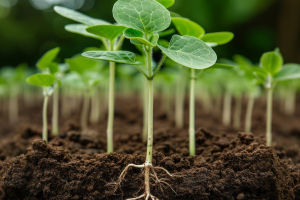Water is undeniably one of the most crucial elements for plant growth, making it an essential component for life on Earth. While soil, sunlight, and nutrients are also vital for plants to thrive, water is the medium that drives most of their key biological processes.
From photosynthesis to nutrient transport, water is a key player in almost every aspect of plant development.
Plants are constantly in need of water to support growth, and without it, they would not be able to survive. But what exactly does water do for plants, and why is it so indispensable? Let's dive into the science behind water's role in plant growth.
The Role of Water in Photosynthesis
One of the most important processes in plants is photosynthesis—the process by which plants convert sunlight into chemical energy, allowing them to produce food. Water plays a critical role in this process.
During photosynthesis, plants absorb carbon dioxide from the air and water from the soil. Inside the plant's chloroplasts, sunlight is used to split water molecules into oxygen and hydrogen. This reaction is essential because the hydrogen atoms are used to create glucose, the plant's food source. In return, oxygen is released into the atmosphere, which is crucial for the survival of many organisms, including humans.
Without water, the photosynthetic process would not occur, and plants would be unable to generate the energy needed for growth. Thus, water is an integral component in ensuring that plants can thrive and grow.
Water as a Transport Medium
Water also serves as a transport medium within plants. Once absorbed by the roots, water travels upward through the plant's vascular system, a network of tubes that transports water and nutrients. This process is known as transpiration.
Transpiration not only helps in moving water and nutrients from the roots to the leaves, but it also assists in regulating the plant's internal temperature. As water evaporates through small openings called stomata, it cools the plant, preventing overheating. In turn, this allows the plant to maintain homeostasis, a state of balance, within its cells and tissues.
Water for Nutrient Uptake
Water is essential for the uptake of nutrients from the soil. Plants need various nutrients, such as nitrogen, potassium, phosphorus, and magnesium, to grow and develop properly. These nutrients are dissolved in the water within the soil and are absorbed by the roots. The water in the plant's vascular system transports these nutrients to different parts of the plant where they are needed.
Without an adequate water supply, plants cannot take up essential nutrients effectively, leading to stunted growth, poor leaf development, and nutrient deficiencies. In addition to water, the availability of nutrients is also heavily dependent on the plant's ability to absorb and transport water efficiently.
Water and Plant Cell Structure
Water is crucial in maintaining the structural integrity of plant cells. Each plant cell is surrounded by a rigid cell wall, which gives the plant its shape. However, it is the water inside the cell that provides the pressure needed to maintain the cell's turgidity. This pressure is known as turgor pressure, and it helps keep plant cells firm and upright.
When a plant does not have enough water, the cells lose turgor pressure, causing the plant to wilt. This is why plants often appear limp and droopy when they are deprived of water. On the other hand, when plants receive adequate water, they maintain their structure, enabling them to stand tall and support their leaves and flowers.
Water and Root Growth
The availability of water also significantly influences root development. Water helps soften the soil, allowing roots to enter more easily and grow deeper into the ground. Roots are essential for anchoring the plant in the soil and for absorbing water and nutrients.
In drought conditions, when water is scarce, plants may develop deeper roots to access underground water reserves. On the other hand, in areas with abundant water, plants may develop more shallow root systems. The root system's development is directly tied to the amount of water the plant can access, which, in turn, influences its overall growth.
The Impact of Water Stress
While water is crucial for plant health, too much or too little water can be harmful. Water stress, which occurs when a plant either receives too much or too little water, can lead to various growth problems.
Overwatering: When plants receive too much water, their roots can become waterlogged, suffocating the plant and preventing oxygen from reaching the roots. This leads to root rot and a decrease in overall plant health.
Underwatering: On the other hand, insufficient water can lead to dehydration, causing the plant to wilt and die. When water is not available in sufficient quantities, the plant's cells shrink, and the processes of photosynthesis and nutrient uptake slow down, leading to poor growth.
It is important to strike the right balance, providing enough water for the plant to thrive but not over-saturating the soil. Proper watering techniques, including checking soil moisture levels and ensuring proper drainage, can help plants get the right amount of water they need for optimal growth.
Conclusion: Water's Indispensable Role
Water is undeniably one of the most important resources for plant growth. From supporting photosynthesis to aiding in nutrient transport and maintaining cell structure, water is at the heart of all plant processes. Without it, plants would not be able to grow, thrive, or even survive.
As we continue to face challenges such as climate change and water scarcity, understanding the vital role that water plays in plant life becomes even more important. By taking care to provide plants with the right amount of water and considering their specific needs, we can ensure that they remain healthy and productive.
So, next time you water your plants, remember: you're not just nourishing them; you're helping them grow, thrive, and contribute to the world's ecosystems. How do you care for your plants' water needs? Let us know your tips in the comments below!


